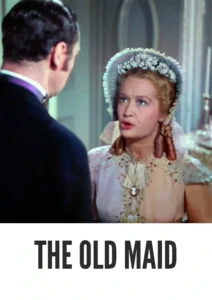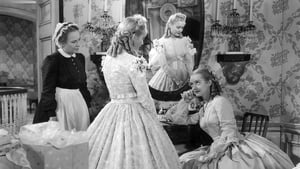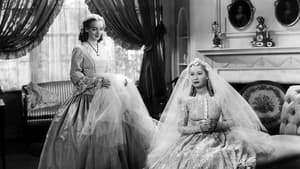Contact: info@alwanfilm.com
Video Sources 0 Views

The Old Maid 1939 Colorized
Synopsis
The Old Maid 1939 Colorized Review: A Classic Drama Reimagined in Color

Introduction
In the annals of Hollywood’s Golden Age, The Old Maid (1939) stands as a poignant testament to the dramatic storytelling and powerhouse performances that defined the era. Directed by Edmund Goulding and featuring Bette Davis and Miriam Hopkins in a compelling clash of wills, the film explores themes of love, sacrifice, and societal expectations. Originally filmed in black and white, The Old Maid was later released in a colorized version, offering a fresh visual take on this emotionally charged narrative. In this article, we will explore the impact of colorization on The Old Maid, its significance within the broader context of film history, and how it influences the viewing experience.
Check The Full Colorized Movies List
Check Our Colorized Movies Trailer Channel
Understanding The Old Maid 1939 Colorized: Director, Cast, and Genre
Director’s Vision
Edmund Goulding was known for his ability to craft emotionally rich narratives, and The Old Maid is no exception. As a director who excelled in bringing out the best in his actors, Goulding’s vision for the film was to showcase the complexities of human relationships against the backdrop of 19th-century American society. Adapted from the Pulitzer Prize-winning play by Zoe Akins, which itself was based on Edith Wharton’s novella, The Old Maid is a deep exploration of hidden emotions and the consequences of choices made under societal pressure.
Goulding’s meticulous attention to character development shines through in every frame of The Old Maid. His ability to draw out the nuanced performances from his lead actresses, Bette Davis and Miriam Hopkins, gives the film its emotional depth. The director’s mastery over melodrama, his use of close-ups to convey intense emotion, and his tight control over the pacing make The Old Maid a powerful film that resonates with audiences long after the credits roll.
The Iconic Performance of Actors
Bette Davis and Miriam Hopkins deliver unforgettable performances in The Old Maid (1939), their on-screen tension mirroring their infamous off-screen rivalry. Davis plays Charlotte Lovell, a woman who gives up her child in a heartbreaking act of love and self-sacrifice. Davis’ portrayal of Charlotte is filled with internalized pain and quiet strength. Her ability to convey the torment of unspoken emotions is truly masterful, and this role is often cited as one of the highlights of her career during this period.
Miriam Hopkins, as Delia Lovell, plays Charlotte’s cousin and the person who ultimately adopts her illegitimate daughter, leading to a life-long conflict between the two women. Hopkins, with her more theatrical style, contrasts sharply with Davis’ restrained performance. This dynamic creates a palpable tension that drives much of the film’s drama. Supporting actors, including Donald Crisp and Jane Bryan, round out the cast, but it is Davis and Hopkins who command attention, their performances elevating the film to classic status.
Exploring the Genre
The Old Maid is firmly rooted in the melodrama genre, a style of filmmaking that emphasizes emotional narratives and heightened conflicts. Melodramas often focus on domestic life, personal sacrifice, and moral dilemmas, all of which are central themes in The Old Maid. The film explores complex relationships, particularly between women, making it an exemplary piece of feminist cinema from a time when such stories were not commonly told on the big screen. By blending romance, tragedy, and family dynamics, The Old Maid exemplifies the powerful, character-driven stories that melodramas excel at portraying.
Exploring the World of The Old Maid 1939 Colorized: Plot and Characters
Detailed Synopsis
The Old Maid (1939) tells the story of two cousins, Charlotte (Bette Davis) and Delia Lovell (Miriam Hopkins), whose lives are forever altered by a shared secret. The film is set in Civil War-era Philadelphia, where Charlotte becomes pregnant out of wedlock by her former lover, Clem Spender (George Brent). In a society that frowns upon illegitimacy, Charlotte hides her daughter, Tina, and presents herself as her aunt. Delia, who marries another man, adopts Tina as her own, creating a complicated and tense dynamic between the two women.
The narrative follows Charlotte’s internal struggles as she watches her daughter grow up without knowing her true identity. Delia’s attempts to control the situation lead to an escalating conflict between the cousins, ultimately culminating in a tragic but inevitable revelation. The film’s focus on the societal pressures placed on women, especially in terms of motherhood and respectability, provides a rich tapestry of emotional and moral dilemmas.
Charlotte’s evolution from a passionate young woman to a heartbroken and resigned figure serves as the emotional core of the film. Her relationship with Tina, though constrained by secrecy, is fraught with unspoken love and sorrow. Meanwhile, Delia’s manipulation and moral rigidity add complexity to her character, making her both a villain and a victim of the same societal expectations.
The Art of Film Colorization
Understanding the Process
Film colorization, particularly when applied to classic black-and-white films like The Old Maid (1939), is a painstaking process that involves adding colors to each frame of the film. Early colorization methods involved manually painting color onto black-and-white frames, but advancements in digital technology have allowed for much more sophisticated techniques. Modern digital colorization uses algorithms to match shades, lighting, and textures, aiming to maintain the film’s original aesthetic while providing a new visual experience.
Colorization of The Old Maid brought the film into a new era, allowing audiences to experience the rich textures of the film’s historical settings in a fresh way. The lush costumes, period settings, and moody interiors of the Lovell household all take on a new vibrancy when viewed in color, offering a visual richness that the original black-and-white film could not achieve.
Development Over Time
Film colorization has developed significantly since its inception. While early attempts were often criticized for their garish or unnatural color schemes, modern technology has allowed for much more subtle and realistic results. The colorization of films like The Old Maid is part of a broader trend of revitalizing classic cinema for new audiences, making these films more accessible and visually appealing to younger generations.
Early Colored Films: A Brief History
The Emergence of Color in Cinema
The transition from black-and-white to color film was a gradual process that began in the early 20th century. Early color films used techniques like tinting, where a single color would be applied to the entire frame, or two-color systems like Cinecolor, which produced a limited range of colors. These early methods were far from perfect, often resulting in unnatural or muted color schemes.
The breakthrough came with the introduction of Technicolor in the 1930s, a process that used three separate strips of film to capture red, green, and blue light. This process produced vivid, lifelike colors and became the gold standard for color filmmaking. By the time The Old Maid was made in 1939, Technicolor was being used in major Hollywood productions, although many films were still shot in black and white due to cost and artistic preference.
The Old Maid 1939 and Its Early Colored Version
The Decision to Release in Color
The decision to colorize The Old Maid was likely driven by the desire to introduce the film to modern audiences who may not be as inclined to watch black-and-white films. By adding color, the film takes on a new visual dimension, making the lush historical settings and intricate period costumes more engaging for contemporary viewers.
Impact on the Visual Narrative
The colorization of The Old Maid brings the Civil War-era setting to life in ways that the black-and-white version could not. The colors of the costumes, the richness of the Lovell home’s interior, and the beauty of the outdoor scenes are all enhanced, giving viewers a more immersive experience. However, this visual enhancement also raises questions about the film’s original tone. The stark contrasts and shadows of the black-and-white version contributed to the film’s somber, melancholic atmosphere, which some may feel is diminished in the colorized version.
The Debate Over Film Colorization
Controversy Surrounding Colorization
Film colorization has long been a controversial subject, with critics arguing that it can distort the original artistic vision of the filmmakers. Directors and cinematographers of the past chose to shoot in black and white for a reason, often using the medium to create specific moods and tones. Colorizing these films, some argue, can undermine these artistic choices.
On the other hand, proponents of colorization argue that it helps preserve classic films by making them more appealing to modern audiences who might otherwise overlook them. In the case of The Old Maid, the colorization allows viewers to experience the film in a new way while still retaining the emotional core of the story.
Examining The Old Maid 1939 as an Early Colored Film
Enhancement or Distraction?
For some, the colorization of The Old Maid enhances the film’s viewing experience, adding visual richness to the period setting and allowing the detailed costumes and sets to shine. However, others may feel that the addition of color distracts from the film’s emotional and thematic depth. The original black-and-white version’s use of shadow and contrast helped convey the inner turmoil of the characters, something that might be lost in the colorized version.
Ultimately, whether colorization enhances or detracts from the film depends on the viewer’s personal preferences. Some may appreciate the fresh take on the classic, while others may prefer the timeless elegance of the black-and-white original.
Influence and Legacy: The Old Maid 1939 Colorized’s Impact on Cinema
A Touchstone for Female-Driven Drama
The Old Maid (1939) was a significant film in the genre of female-driven drama, particularly in its portrayal of complex, flawed women who make difficult choices. The film’s focus on the emotional struggles of its lead characters set the stage for later films that would explore similar themes, such as Now, Voyager (1942) and Mildred Pierce (1945).
Its Influence on Future Generations
The film also served as a benchmark for subsequent filmmakers interested in adapting literary works with a focus on strong female protagonists. The performances of Davis and Hopkins remain iconic, and their portrayals of complicated, morally ambiguous women have influenced many actors who followed in their footsteps.
Director’s Cinematic Legacy: Beyond The Old Maid 1939 Colorized
Edmund Goulding, who directed The Old Maid, is remembered as a versatile filmmaker capable of handling a wide range of genres. His work spanned melodramas, comedies, and even the occasional musical, but it is his ability to elicit powerful performances from his actors that remains his lasting legacy. The Old Maid is one of several films Goulding directed that featured strong female leads, showcasing his talent for creating rich, emotionally resonant stories.
Themes Explored in The Old Maid 1939 Colorized
Darkness, Sacrifice, and Redemption
At its core, The Old Maid is a story about the sacrifices women make in the name of love and duty. Charlotte’s decision to give up her child, and Delia’s subsequent manipulation of that situation, highlights the societal pressures that force women into impossible choices. The film explores themes of hidden guilt, the burden of societal expectations, and the lengths to which individuals will go to protect their loved ones.
These themes are still relevant today, making The Old Maid a timeless exploration of the human condition. The emotional weight of the story, combined with the film’s focus on complex female characters, ensures its place in cinematic history.
Reception and Controversy Surrounding The Old Maid 1939 Colorized
Initial Reviews and Audience Reactions
The Old Maid was well-received upon its release in 1939, with critics praising the performances of Davis and Hopkins. The film’s emotional depth and exploration of difficult moral questions resonated with audiences, making it a commercial success.
The colorized version, however, has been met with mixed reactions. While some viewers appreciate the added visual appeal, others feel that the colorization diminishes the film’s original atmosphere and emotional intensity.
Where to Watch The Old Maid 1939 Colorized Online
For those interested in watching The Old Maid (1939), the film is available on several streaming platforms, including Amazon Prime Video, Turner Classic Movies, and HBO Max. Both the original black-and-white version and the colorized version can be found online, giving viewers the option to choose their preferred viewing experience.
FAQs About The Old Maid 1939 Colorized
Q: Who directed The Old Maid (1939)?
A: The Old Maid (1939) was directed by Edmund Goulding, a versatile filmmaker known for his work in drama and melodrama.
Q: What is the significance of the colorized version of The Old Maid?
A: The colorized version of The Old Maid offers a new way to experience the film’s historical setting and intricate costumes, adding a layer of visual richness that the original black-and-white version does not provide.
Q: What themes are explored in The Old Maid?
A: The film explores themes of love, sacrifice, guilt, and societal expectations, with a particular focus on the emotional struggles of women in 19th-century America.
Conclusion
The Old Maid (1939) remains a classic example of melodrama, driven by powerhouse performances from Bette Davis and Miriam Hopkins. The film’s exploration of sacrifice, love, and societal pressure continues to resonate with audiences today. While the colorized version adds a new visual dimension to the story, it also raises questions about the impact of colorization on classic films. Whether viewed in its original black-and-white format or in its colorized form, The Old Maid remains a testament to the enduring power of emotional storytelling and cinematic artistry.















